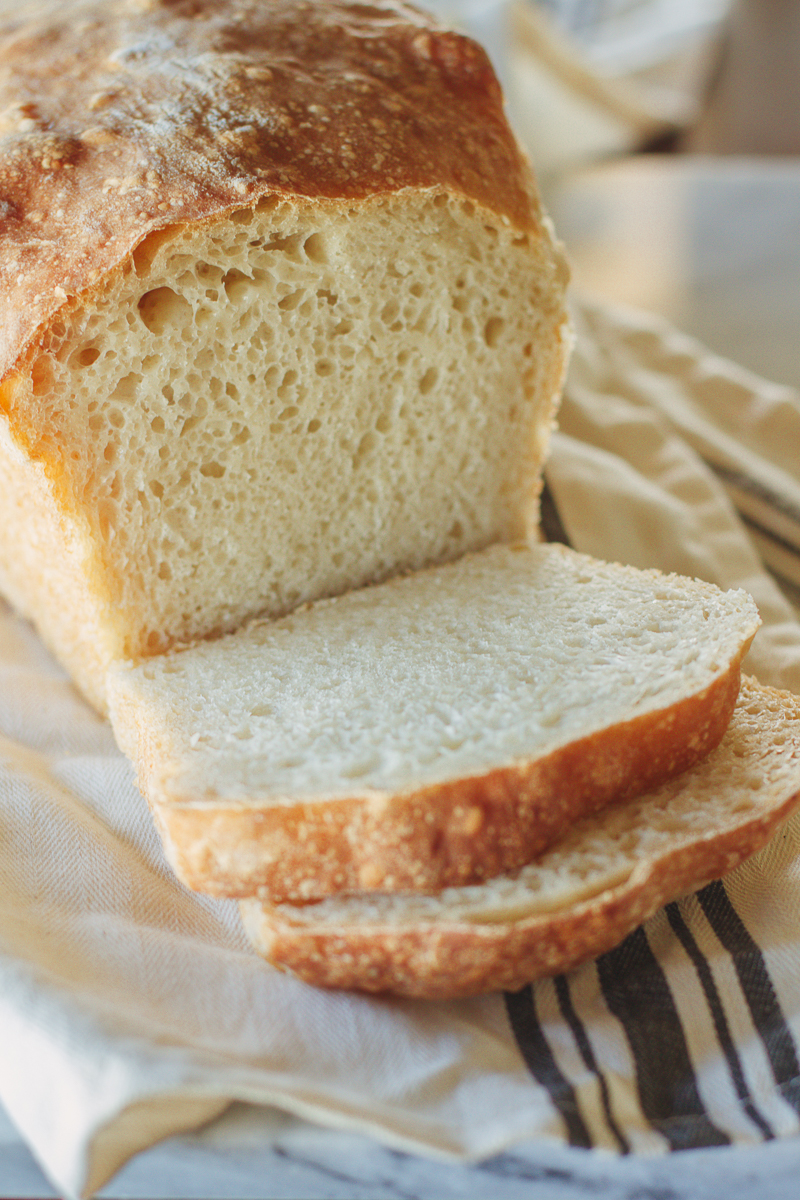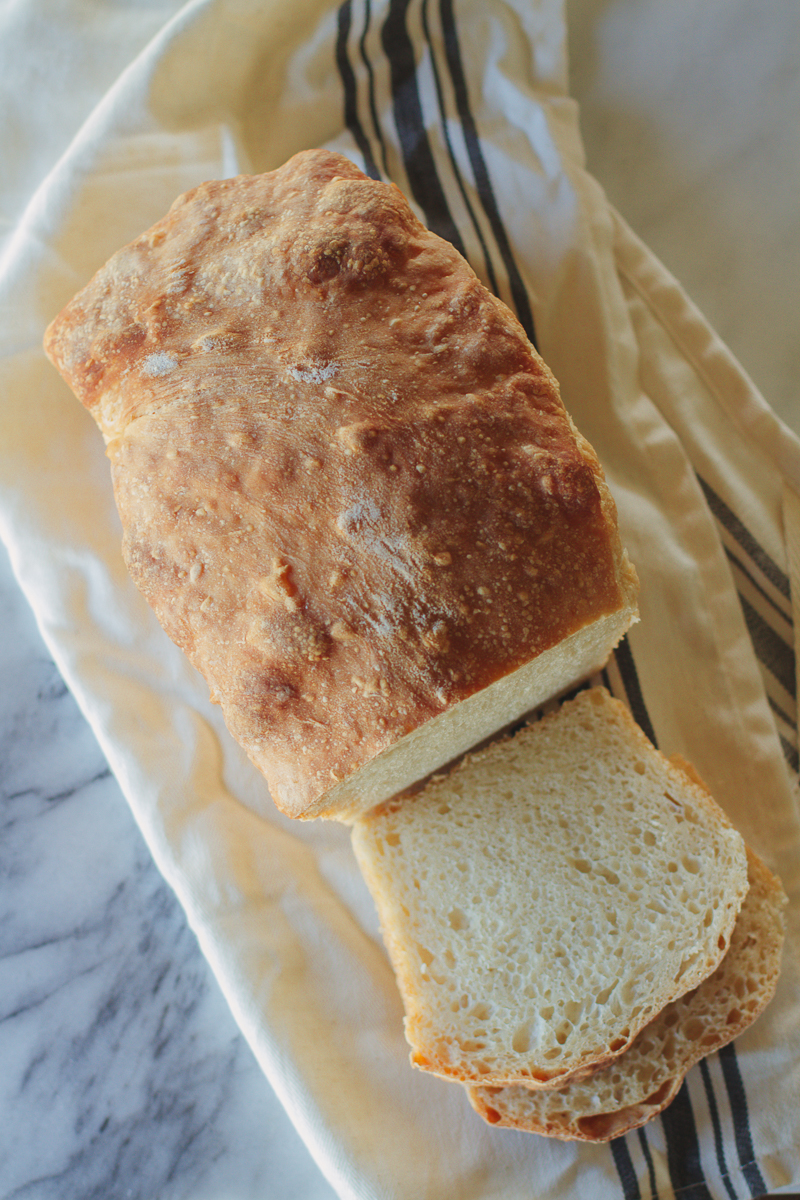
Honestly, I feel the least qualified to be writing this post, however, the people have spoken. Whenever I share about my sourdough bread, I always get messages asking questions and wanting my recipes. So, I decided I would compile everything I’ve learned about sourdough into a post to hopefully serve as a resource for those who are wanting to take the plunge.
My Experience with Sourdough
I tried twice to make my own starter, I used Joshua Weissman’s recipe via Youtube. The first time I did it, it ended up molding before being ready to use, which I later learned was due to a storage issue. The second time, I don’t think I was feeding it enough or priming it enough to bake with it and my breads were not turning out. They were flat and dense due to a starter that wasn’t active enough. Now that I know what I know, I probably could start a starter again – however, I didn’t want to mess with trying to start my own starter and wait the 2-3 weeks for it to mature enough to bake with. So I ordered an already mature and ready to bake with starter from King Arthur Flour. I literally fed it a couple of times and then baked with it immediately. It has been great!
The Starter
The basis of all sourdough is starter. Starting your own starter is super simple, literally, it is flour and water mixed together and given the time to let ferment to create “wild” yeast. However, starting your own starter takes time to allow the starter to mature, anywhere from 2-3 weeks. There is really no wrong or right way to make, feed, and use a starter and there are a million different recipes that work. Feel free to try your hand at making your own or purchasing a starter, whatever works for you! Side note: since sourdough has become a big thing, you can always crowdsource for starter too – there may be someone in your area who will gladly share their starter with you!
Maintaining Starter
Alright, now you’ve got a starter, you need to feed (maintain) it. Essentially all a feeding is doing is maintaining the activity level of the starter and cultivating that wild yeast so you can successfully bake with it. There are many different ways in which you can feed and maintain a starter, mostly depending on how often you are going to be making bread. Here is a good resource on the different methods.
If you bake a lot, you may want to keep it on your counter, at room temperature. While this means feeding it once or twice a day, it also means your starter will most likely always be ready to use.
However, the vast majority of us probably aren’t going to be baking every single day or even more than once a week. And many of us probably don’t want to be wasteful with utilizing flour for so many feeds when we aren’t going to be using the starter as much. If you’re more of the casual sourdough baker, it’s possible to store your starter in the refrigerator, feeding it several times before you’re ready to use it. This is the method I utilize in order to bake on the weekends.
Since I don’t have a need to bake every couple of days, I keep my starter in the fridge during the week and bake on the weekends. Here’s been my current feeding schedule:
- Thursday Morning – pull starter out of the fridge
- Friday morning and Friday evening – feed starter
- Saturday morning – start bread recipe (pulled from the fed starter)
- Saturday evening – feed starter
- Sunday morning – place my starter back in the fridge until Thursday again
The key to this schedule is giving the starter enough feedings in order to regain its activity and produce a successful loaf of bread.
Feeding the Starter
Every time you feed you’ll want to discard a portion of the starter, otherwise you’ll end up with an endless amount of sourdough starter. You can use the discard starter to make things like pancakes, waffles, cake, pizza, flatbread, literally the options are endless. Or this is how you would share your starter with a friend so he or she can create his or her own starter. How much starter you choose to maintain and feed it up to you and how much starter you’ll be needing to use. Recipes will vary on how much to maintain and also what ratios to feed your starter. I maintain a 1/2 cup (113 g) of starter each time and it works for my usage. If I need more starter for any given recipe, I will simply feed my discard and start another portion of starter.
For each feeding, I remove a portion of the starter (discard) and then add equal parts flour and water to the starter. So for me, that is 113 g of starter, 113 g of water, and 113 g of all-purpose flour. Some starter recipes will use rye flours or other types in their feedings, but I find one that uses all-purpose flour is easiest for me.
A couple of notes about feeding, first, I highly recommend using a kitchen scale in order to measure your ingredients versus using a measuring cup. You will be far more precise and successful using a scale, which comes into play when you are ready to bake bread. Second, weigh your starter container empty and write that weight on the container so you know how much starter to keep. For example, my container (link here) weighs 706 g empty + 113 g of starter, I leave 819 total grams each time I discard and feed. Third, no matter what kind of flour you are using make sure it isn’t bleached and also be leery of the water you are using, I haven’t had any issues with our tap water, but I do know the treatments in some people’s tap water have caused activity issues in their starter.
The gold standard of an active sourdough starter is the starter doubling in volume within ~6-8 hours of being fed. This means the starter is active, strong, and you’re likely to get a really good result when baking it with it. If you are wanting to help the starter a little bit or live in a particularly cold or drafty house, you can put your starter in the oven with the light on (NO HEAT!) to provide it with a somewhat temperature controlled, slightly warm environment. Remember to remove before pre-heating the oven, or you will kill (bake) the starter. It might take a few feedings to get your starter to a point where it is consistently doubling and showing signs of good activity.
If you are struggling with a less-active starter, try feeding it more than once per day to really get it going and active. Keep repeating that twice a day feeding until your starter IS doubling within 6-8 hours of feeding it. It might take a couple of days. Here is a good resource for troubleshooting sourdough starters.

My Favorite Bread Recipes
Okay, so you’ve got your starter and it’s active! Now you are ready to bake bread!
As far as bread recipes go, the sky is the limit! But before you begin, start out with an open mind and know that this will be a learning process. Some loaves may not turn out and some may be a stunning success and that is okay! Baking is really a science with so many variables, so dialing every single recipe in perfectly takes time and practice.
I started with boules (round loaves) that are more rustic with spotty success – sometimes they turned out wonderful and sometimes they would turn out dense and flat. This could have been due to several different variables, the recipe I was using, or the ratios I was using. Now I have found a sweet spot making tin loaves (more traditional loaves) in a loaf pan and I am loving the results! I also feel like I have far more versatility with a tin loaf. The tin loaves can be a little more cumbersome to handle and shape than a rustic loaf, but there are some good resources out there to help visually show you some tips and tricks.
Also another note, you may notice that most of the sourdough recipes take a long time and require proofing (rising) overnight or over long periods of the day, this is an element of baking sourdough and it is what gives sourdough that tangy flavor. It may seem intimidating at first, but I promise that most recipes are fairly hands off and have a lot of inactive time. Once you start trying several recipes, you’ll find one that works for you and you’ll develop a weekly baking schedule of your own. I have adapted the sourdough sandwich bread to fit our schedule and due to the simplicity of it, it has been my go-to lately.
Sourdough Boule Recipes I’ve Tried
No-Knead Beginner Sourdough Bread by Joshua Weissman
Sourdough Recipe: A Beginner’s Guide by The Clever Carrot
Beginner Sourdough Bread by The Perfect Loaf
Sourdough Tin Loaf Recipes I’ve Tried
The Simple Sourdough Tin Loaf of Your Dreams by Baked NYC
Easy Sourdough Sandwich Bread by Alexandra’s Kitchen — my current go-to recipe
My Favorite Discard Recipes
Now back to discard, I mentioned that you can use your discard in order to make a whole variety of baked goods from pizza dough to cakes and even waffles. I have tried several recipes utilizing my discard. I don’t always save up my discard every time I feed, however, if I want to use it for a recipe I will save my discards up in a jar in the fridge so I have ample supply for usage. I like to try and utilize my discard for recipes I am already making or needing, however, much like breads the sky is the limit on what you can utilize your discard for. Honestly, pretty much any dough recipe you love you can utilize sourdough discard in, you’ve just got to do the math to reduce the amount of flour and water (and sometimes commercial yeast) in it in order to have success. I’ll share a couple of recipes I’ve tried as well as some that I still want to try.
Hands down my favorite usage for my discard, this produces the best pizza crust I’ve ever made! I also have frozen this and used it with success. To freeze this recipe, I will mix it all up, place it into a well-oiled Ziploc bag, and let it rise for about an hour before placing it into the freezer. When I am ready to use it, I pull it out of the freezer the night before and the next day I give it several hours to rise at room temperature before I am ready to use it. It works fabulously and creates this delicious crust with a great bite.
When I want to make waffles, of course, I am going to use my discard in them. This recipe is simple, however, it does take some inactive time of letting it sit overnight, so make it the night before you’re ready to use it.
Here are some recipes I want to try:
Sourdough Tortillas by Pies and Tacos
Cinnamon Raisin Sourdough Bread by King Arthur Flour
Sourdough Dinner Rolls by King Arthur Flour
Sourdough Hamburger Buns by King Arthur Flour
Sourdough Banana Bread by the Clever Carrot
Sourdough Cinnamon Rolls by the Clever Carrot
Sourdough Cheddar Crackers by Hearts Content Farmhouse
One Bowl Sourdough Chocolate Cake by Hearts Content Farmhouse
Sourdough Lemon Cake by Hearts Content Farmhouse
Blueberry Sourdough Muffins by King Arthur Flour
